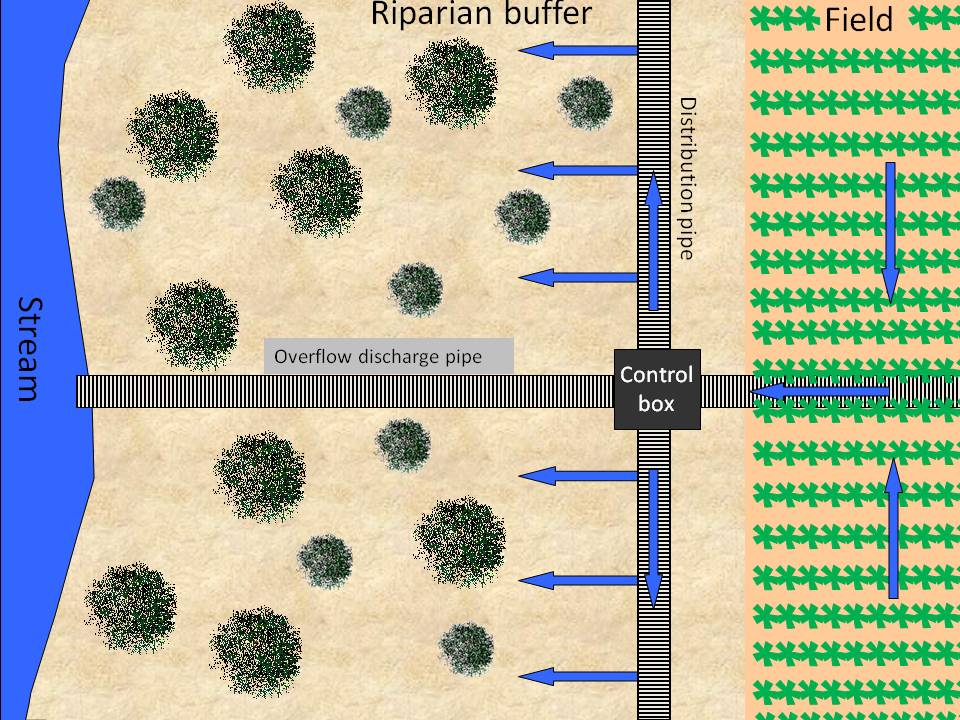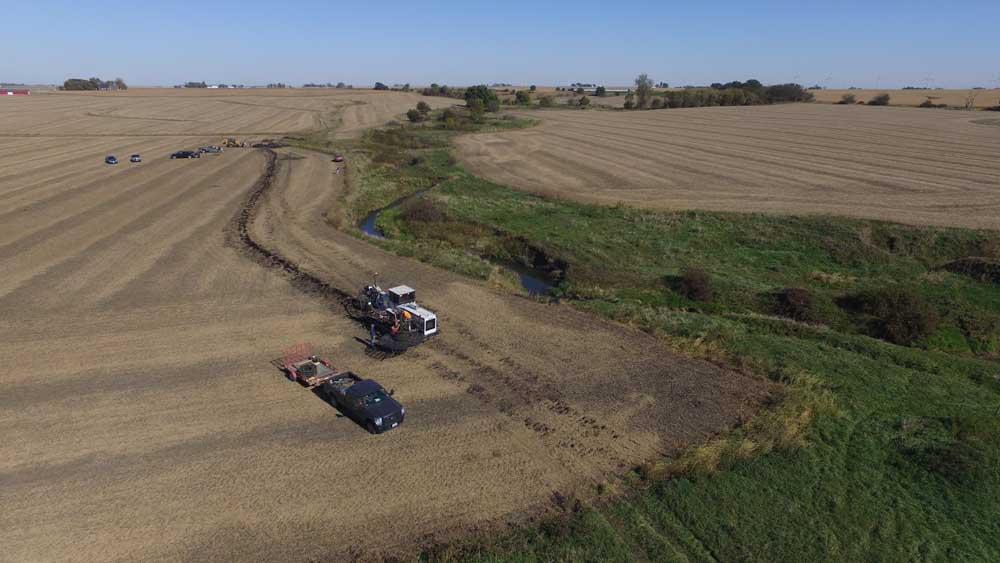For the past few years, Dr. Dan Jaynes, USDA-Agriculture Research Service, and Dr. Tom Isenhart, Iowa State University, have been researching ways to remove nitrogen from tile water. Their research culminated in the development of saturated buffers, a new water protection practice. Saturated buffers rely on denitrifying bacteria to convert nitrates within the tile water to nitrogen gas, before the water is discharged into a water body. Jaynes and Isenhart have developed a method to intercept tile water that would otherwise flow directly into a stream or river. The intercepted water is fed through shallow tile lines, or distribution pipes, that run underground and parallel to a stream, resulting in removal of a significant of the nitrates.

Early research indicates that a well-designed saturated buffer can remove, conservatively, 35% of the nitrates delivered through a tile line. © Dr. Dan Jaynes, USDA-ARS
How Saturated Buffers Work
Using a pretty simple hydrological/biological concept, the saturated buffer intercepts the water from a tile line about 30 to 50 feet from the edge of water body. Next, the water is diverted into shallow, perforated tile lines (distribution pipes) that run parallel to a stream or river. To be effective, the tile lines must be installed in a grassed buffer, seeded to permanent vegetation (e.g., vegetative buffer strip). As the water is redirected into the perforated tile, it flows out into the soil, raising the water table throughout the entire length of the vegetated area. The higher water table within the buffer saturates the soil and enables the natural biological uptake and denitrification processes to reduce nitrogen in the water. The denitrification process that occurs in the saturated buffer decreases the amount of nitrogen that drains through fields – from croplands to surface water.
Installation of a saturated buffer before establishment of a new riparian buffer. Photo by Lynn Betts. This project was supported by an Iowa NRCS funded Conservation Innovation Grant to the Soil and Water Conservation Society.
Jaynes reports that a properly designed saturated buffer costs approximately $5000 and removes, on average, 35% of the nitrate flowing through the tile line. To me, that nitrate reduction is significant. Perhaps even more importantly, saturated buffers do not require regular maintenance, so the nitrogen-filtering benefits are realized year after year. Imagine the positive impact that saturated buffers could have on water quality goals. When the goal of a farmer is to improve water quality, we should talk about the benefits of simple and efficient practices like saturated buffers.

 Irrigating the Upper Midwest
Irrigating the Upper Midwest
Can you explain to me why nitrate entering natural wetlands converts to NOx but nitrate entering these artificial buffers converts to N2? Sounds like the belief (but not the fact) that nitrogen in large manure lagoons magically converts to N2 as well.
Lon, great question. I had exactly the same concerns. It is critical we don’t just trade one resource concern for another. I discuss this with Dr. Dan Jaynes. Dr. Jaynes said, “bottom line is riparian buffers with saturated buffers emit much less N2O than if planted in row crops.” I will email you the research paper that Dr. Jaynes sent to me when I asked him a similar question.
Nitrous Oxide Emissions from Saturated Riparian Buffers: Are We
Trading a Water Quality Problem for an Air Quality Problem?
Morgan P. Davis,* Tyler A. Groh, Dan B. Jaynes, Timothy B. Parkin, and Thomas M. Isenhart
Lou
A key component to the proportion of N2 and N2O in emissions is the availability of carbon to help the chemical processes. If you read the study you will see that a factor identified for IDing site suitable for effective saturated buffers is the soil carbon content
Skip,
Thank you for your comment on N20 emissions.
It seems increasingly clear that technology can not solve all of the problems caused by an over domesticated landscape and an over consumptive culture. Steep slopes and floodplains must be restored to natural, self-regulating systems (woodland, wetland, and prairie). The corn-soybean-motor fuel-animal feed model is not a long term plan. We must create a low input, sustainable culture which will then allow for the emergence of a low input, sustainable agriculture. Millions of acres now used for agricultural purposes must be permanently wild. Millions of additional acres now in row crop must be in managed perennials. We must redefine what it means to be happy and successful. We must recognize limits. We must create a wilder, more beautiful, more biologically diverse, and a more enduring Mississippi River Watershed.
Roger, thank you for your response. Your comments are always so insightful. I am not even sure how to respond, but I truly appreciate you comments. Keep them coming.
Tom
I am pleased to read that you are helping bring attention to the benefits from saturated buffers. That said you failed to note the importance of the Conservation Reserve Program in this effort. Note that all of these saturated buffers were installed on Continuous CRP buffers. CRP helps make saturated buffers feasible for farmers by compensating them for withdrawing environmentally important land into buffers. By installing the water control structures and elevating the water level into the root zone, saturated buffers helped make CRP even more effective.
Also, your post gave credit to NRCS’s CIG program which is appropriate; however, you neglected to note that FSA’s Monitoring Assessment and Evaluation program also funded this research.
Skip Hyberg
H & H Conservation
Skip, you are absolutle correct. I did fail to note USDA’s Farm Service Agency’s (FSA’s) role in Saturated Buffers. Since farmers do not obtain any economic benefit from installing saturated buffers it is critical that USDA, through the Farmn Service Agency, provide costshare making these practices viable. Equally important is the assessment and evaluation funds provided by FSA. Apologies for the oversite. I sincerely appreaciate FSA’s contribution to the success of saturated buffers.
I only have a question. How do you keep the perforated tile from being plugged with roots after a few short years? All our perforated tiles have been plugged by roots in our buffer strips. we have even had to replace mains with non perf tile to correct it.